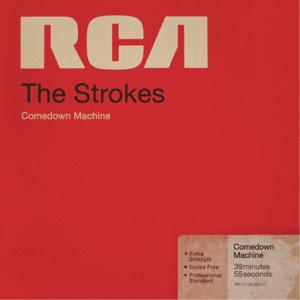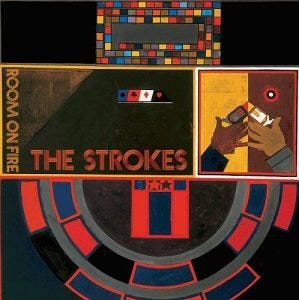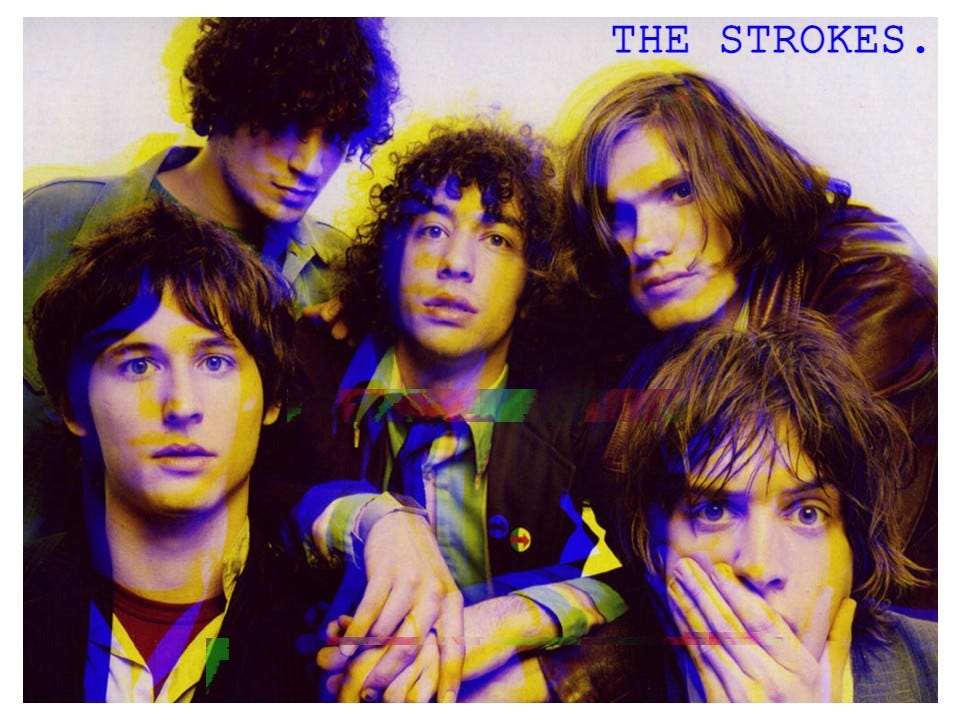A Ranking of Every Album by The Strokes
Months of indecisiveness and writing have finally led to this highly-anticipated moment: rambling about incredible music by talented nepo babies in quite possibly the worst outfits you will ever see.
I feel like everyone in the indie/modern rock community has very strong, very polarizing opinions about The Strokes (myself included). Namely, The Strokes have fallen victim to nostalgia—that is, what people call “The Strokes” tends to be a romanticization of Is This It and The New Abnormal (because, let’s be honest, it sounds like a better-quality Is This It). Room on Fire and the two electronic-based albums tend to get pushed aside (although people love “Reptilia”) because they’re not the first album, and First Impressions of Earth never enters typical conversations about the band’s discography. Moreover, much of their work in the 2010s were overshadowed by Casablancas’ side projects—The Voidz, his solo album, and his (excellent) collaborations with Daft Punk for Random Access Memories—so they haven’t been given the proper attention the first, second, and latest album got.
Until today!
After spending many hours relistening to the songs (…and writing this article because I started writing in MAY), here is my detailed ranking of every released album by The Strokes:
6. First Impressions of Earth (2006): Ok, there may be a reason why First Impressions of Earth often gets ignored in discussions about the legacy of The Strokes. It’s not a bad album; some of the band’s best songs (“Juicebox,” “Heart in a Cage,” and “Fear of Sleep”) are in this album. It’s simply…unremarkable. Even though they made a huge departure from their first two albums by leaning more into hard rock, surf, and 80’s new wave in some parts—and I appreciate the variance in sound and bolder approaches to vocals that work extremely well—most songs begin to sound the same. First Impressions feels too long; even though the 14 tracks keep it under an hour, the hard mood shifts, exhausting pacing, and similar, catchy guitar riffs remind the listener that the option to just quit and do something else at any moment is always present. The song order does not make sense: the transitions between “Visions of Division” to “Ask Me Anything” to “Electricityscape” force the listener to shift from screaming and heavy guitars to sobering and beautiful strings then back to fast-paced heavy electric guitars. It’s impossible to keep up with the progression of the album. Lastly, in my opinion, the band accidentally made an album with two mini-albums in it. At least half the songs on the album belong on an album that could have included the “Hawaii” single (unreleased until 2023), and the other half belonged under the haunting, edgy themes First Impressions meant to explore. “Heart in a Cage” is, however, one of the best Strokes songs they’ve written. Also, more Strokes albums need Casablancas to just SCREAM.

5. Angles (2011): This album is the prototype for the whole Voidz project, as its more electronica-based music clearly gave Casablancas the foundation he needed to get crazier with it with another band. Angles was a much more successful departure from the classic garage rock of the Is This It days than First Impressions, but in many cases, it fell back on old tropes to off-set the more 80’s synth wave-inspired track that, ironically, made the album way better. People often cite “Under Cover of Darkness,” “Taken for a Fool,” and “Gratisfaction” as the triumphs of the album, and while the first song is undoubtedly legendary, the other two are just better produced Is This It songs. The real standout tracks of Angles are “Machu Picchu,” possibly one of the best openers for a Strokes album, and “Games” because both these boldly commit to the electronica, synth, and new wave motifs that inspired the album. “You’re So Right,” while not as good as other songs, also fully embraces the new sound the Strokes are trying to achieve, as it evokes the same energy as that era of 80s pop music that produced hits like “Mr. Roboto,” “Safety Dance,” and whatever the B-52s had going on. The album was at a perfect length: any more of this game of the Strokes doing something awesome and bold then immediately retreating to their comfort zone would have been exhausting. It’s a good album—no song was particularly bad—the Strokes just missed their chance to deliver on their promise of something entirely new, exciting, and bold.

For the next two albums, we have our first ever TIE. So, tied for third place are:
Is This It (2001): For a debut album for an indie rock band in the early 2000s, Is This It was the debut album. Even now, the album embodies youth culture: the tongue-in-cheek nature of “Is This It,” “Someday,” and “Barely Legal” (which aged poorly for a certain dude making fun of his dad for dating women half his age). The energetic and carefree sounds and themes of “The Modern Age,” “Last Nite,” and “Hard to Explain.” The rebellious, wild, and edgy (at the time) track that was “New York City Cops” (originally titled “Pigs” and only released in non-American editions of the album because…September 2001). Is This It is a perfect time capsule of being teenagers in New York City during the early 2000s, and it made the band look so cool that every indie rock band after them just wanted to sound exactly like the Strokes. However, the debut album, while it has its timeless bangers, was not the best the band could do. Though at a perfect length, with no excess tracks jammed in there, and with excellent cohesion in the tracks, it still has its flaws. Aside from “The Modern Age” and “Last Nite,” which are the most compelling tracks in both vocals and music, the band’s interesting aspects rely on Casablancas’ unique vocal range. The music is a standard 4-piece rock band, and while the guitar riffs are good, they aren’t the best quite yet—except for “The Modern Age,” where the guitar solo is the best and longest part of the song. There are hints of potential in “Soma” and “Hard to Explain” that the guitar riff motifs will become essential for the identity of the band, but again, most people are paying attention to the star of the show in these songs: Julian Casablancas’ voice. Partly due to time, because we’ve been listening to these bangers for over 20 years, Is This It has some of the strongest consecutive order of tracks, making the album nothing but iconic and legendary.

The New Abnormal (2020): As I said in the beginning of this article, The New Abnormal is Is This It revamped. I do appreciate the length of the tracks—all are in the 4 to 6-minute range—compared to the number of songs on the long-anticipated album (we waited 4 years for 9 songs). Also, I do like how aggressively New York they got throughout the album by selecting a New York icon’s art (Jean-Michel Basquiat’s Bird on Money) as their cover art and using a lot of NYC cultural references in their titles and lyrics (shoutout to “Brooklyn Bridge To Chorus” and “Ode To The Mets”). They brought back careless fun in “The Adults Are Talking”, “Bad Decisions,” and “Eternal Summer” while also staying true to their grumpy old man-sonas with “Brooklyn Bridge To Chorus” and “Why Are Sundays So Depressing.” I think this is some of the most fun The Strokes ever had with sound exploration: I’m personally obsessed with the groovy electric guitar and stadium organ they use as the keys section for most of the songs, as well as the falsetto Casablancas adopts in the verses of “Eternal Summer,” especially when he naturally shifts between that and the shouting/alto voice. For this album, its most successful aspect is that the band just lets the songs play for as long as they need to keep grooving. Though we get the best vocals, the jamming in the instrumental solos was the best and most fun part of The New Abnormal. This album just sounds good; there’s no deeper analysis necessary.
I’m also half-convinced the release of this album is the reason why every dude in New York City now walks around wearing the Basquiat x Uniqlo collection t-shirts, specifically the one with just the crown. If you lived in New York after 2020, you know the one I’m talking about.

2. Comedown Machine (2013): This is my hottest take: Comedown Machine is THAT album. I know that this album caused the band to go on “hiatus” (they released an EP in 2016, so it’s not like people were starving for new music) and regroup before The New Abnormal, so it has a devisive history. They also did no media promotion for this album whatsoever, even letting people download the first single for free on any available platform, so it makes sense that Comedown Machine didn’t do too well. I also recognize that indie rock in 2013 had such a distinct sound (shoutout to Arctic Monkeys’ AM and Vampire Weekend’s Modern Vampires of the City), that a retro-sounding 70s/80s electronica album from an already established legend in the scene seemed a little out-of-place. But, for a band that dared to try something new when the scene changed, Comedown Machine ruled. It demonstrates how capable The Strokes are as musicians and songwriters looking to do something fun and different. I don’t care if Casablancas & Co. hate it because they were at their lowest point in terms of collaboration and friendship; it’s f*****g great, and I’m right in having it as my favorite.
As my personal favorite, this album is the only one to depart from the garage/alt rock sound almost completely, (save “All The Time” and “Partners In Crime”) delve into new wave/electronica, and commit to this new sound. This is the only album where I genuinely could identify every track as a part of Comedown Machine, mainly because the way they use the drum, guitar, and keyboard are so distinct and unforgettable. “Tap Out”’s and “One Way Trigger”’s intro riffs are Pavlovian to me; as soon as I hear those iconic riffs, I know I’m immediately going to have a good time. The logic of this album also makes perfect sense. For an album that is mostly fast-paced, mid- to high-energy, placing two songs that bring the emotions down and demand more thought (“80s Comedown Machine” and “Call It Fate, Call It Karma”) in the middle and end was nothing short of genius. Especially after “Welcome to Japan”—a quirky, catchy straight banger with infinite replayability and danceability (can you tell which Strokes song is my favorite?)—”80s Comedown Machine” is incredibly effective in capturing the main theme of this album. Its slow, moody, and highly instrumental sound and lyrics play with the idea of fate—whether your previous bad actions don’t mean anything if your life wasn’t under your control anyway—and become the standout track. “Call It Fate, Call It Karma” acts as the summary of the album; by directly referencing “80s Comedown Machine” in the title (the lyric “I tried to believe in fate / For a second try…” to be exact), it functions as the somber conclusion to all the introspection done in the quiet parts of an otherwise chaotic and wild story. Just analyzing the placement of these two songs alone show that Comedown Machine is much more calculated and thought-out than people give credit.
No track is bad or boring, regardless of tempo or musical choices. “50/50” is the loudest and most intense, but it’s got a sick guitar section, Julian Casablancas screams and sings through that muffling/static-y vocal filter so you know its cool, and it’s a great surge of energy after “80s Comedown Machine.” I’m genuinely happy The Strokes went with the “Slow Animals” version instead of “Fast Animals” to put on the album because it’s cleaner and sounds more in-tune with the rest of the album. “Partners in Crime” is such an iconic Strokes song, and though it’s not as committed to the 80s electronica bit, it still has some traces to tie it back and has that really brief yet incredible guitar solo at the very end. “Chances” is a deep-cut but I feel like best represents the sonic project of the album; it sounds beautiful, has incredible lyrics and vocals, and the instrumentals are phenomenal. “Welcome To Japan” is the best song by The Strokes. I don’t care about anyone else’s opinion. It does something insane to my brain.

1. Room on Fire (2003): Name a better sophomore album from another band/artist. You can’t because this is the best one. I don’t think I can even give a satisfying review; Room on Fire, to me, is just one of those albums you have to listen to just to understand why it’s the best. So, you’re just going to have to either listen to it, trust me, or (and this is the most recommended) both.
For me, the reason why Room on Fire stands as the best album by The Strokes is that it’s a collection of simply outstanding songs. Rarely do we ever get an album where every song is the epitome of cool, catchy, and well produced, and Room on Fire goes crazy in this aspect. For instance, to go from “Reptilia” (a super-cool, fast-paced rock song with one of the best choruses in modern alt rock music), to “Automatic Stop” (a song where it’s best to listen to fully grasp its awesomeness), to “12:51” (literally a perfect song), to “You Talk Way Too Much” (another iconic track with one of the best choruses ever written in the band’s discography) is simply insane in the best way possible. Though some lesser-known songs may be in between two phenomenal and unforgettable tracks (ex. “Between Love & Hate”, which is sandwiched by “You Talk Way Too Much” and “Meet Me In The Bathroom”), they still stand out as individual pieces of music.
Now, I’ve criticized other albums from different artists for writing albums that sound like a collection of hits, so I do not want to confuse that critique with what Room On Fire does. Unlike, for instance, The 1975’s Self-Titled (which I reviewed), Room On Fire undoubtedly has a lot of cohesion among the tracks, not just in sound and vibes. It’s not an album where you can listen on shuffle and get the same experience as listening in order; it has a distinct beginning, middle, and end you have to pay attention to in order to appreciate it. And while this album is more about the vibes of being cool than anything in particular, each song is so high-quality that you don’t really need a story. Room on Fire oozes with talent, a strong sense of identity, and simply phenomenal music.

As always, feel free to listen to my curated Best of The Strokes playlist, and hopefully you’ll walk away with a bigger appreciation for, you know…probably the most important indie rock band of the 21st Century.
Now I’ll end with a final note:

Header image edited by author. All images are credited to their proper owner under the photograph.





